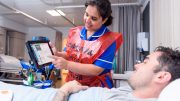In healthcare IT, the stakes are high with patient health and lives at risk if technology doesn’t support safe clinical practice. In spite of this, the sector has lagged against other industries with trusts often running on dated, inefficient systems. Frustrations run high and laborious workarounds are common, which is proven to contribute to staff burnout and impact the health outcomes of patients. Dr Constantin Jabarin, practising senior A&E clinician at Gloucestershire Hospitals NHS Foundation Trust and CCIO at Allscripts, discusses why usability needs to be given greater prominence by both software vendors and NHS IT procurement teams to ensure solutions are the best they possibly can be for end users.
Speak to anyone in the NHS and they will be able to tell you stories of frustrations with technology. Stories of having to log in multiple times, often necessitating different passwords and credentials, because patient notes, observations, test results and radiology images are viewed in different systems. It’s not uncommon to log into all these programmes to view a patient’s information, only to have to change location within the hospital and then start the process again because there is no ‘follow me’ system setup. But not only that – when you have logged in to the right place, it can often take multiple steps, or clicks, to carry out tasks which are repeated many times every day. This is ‘usability’ and is something that is becoming more of a focus point as we understand the impact that this constant frustration has on clinicians, and their patients.
It is my view that usability should be considered in its broadest terms. It is the workflows, or clicks, that a clinician must take when navigating the EPR. But it is also the speed of the solution, which is going to be determined not by the software, but by a hospital’s hardware and infrastructure. Another element is how the user interface looks and specifically, whether it helps the end user navigate the system. Now this may seem trivial but it’s what we have come to expect due to the advancements in technology and our everyday use of apps and devices in our personal lives.
NHSX has launched a national survey to better understand the usability of electronic patient records (EPRs). Its intentions, it says, are to ensure that the technology used every day works for staff, is designed with the user in mind, and that systems deliver all the benefits that they should. The questions focus on whether current EPR systems in use in the NHS meet certain expectations, such as being easy to learn, integrate in and out of the organisation, are flexible and able to be configured in different ways according to different department needs or specialties, and most importantly, that it keeps patients safe.
Now, the intentions behind the survey are admirable. However, I would urge caution when it comes to the interpretation of the results. For the questionnaire will only prove insightful if it is accurate – if those filling it in know which solution they are responding about. Unfortunately, for most users – not all of them, but most – the company logo that they see when they log into their EPR is the company that they will attribute all problems to regardless of whether there is a third-party solution in play. Also, the IT solution is just a tool for the clinician to use – a tool that can be used correctly or incorrectly. If a solution hasn’t been implemented properly, or there are issues with data flow or the way the work processes have been mapped, then it is not going to work as it should.
As a practicing A&E clinician and as CCIO at Allscripts, I probably spend more time than most pondering the issues of usability and the impact that EPR systems have on clinical practice. Systems that are easy to implement and simple to use provide rapid benefits for clinicians and patients. For example, at Bolton NHS Foundation Trust clinicians adapted their Sunrise EPR to meet their specific needs by developing an electronic acute medical list to manage patient referrals. The result was reduction in mortality, decreased length of stay and less readmission. Not only that – the solution was a vast improvement on existing clinical practices. The technology replaced the use of pagers, verbal referrals, handwritten referral lists and manually updated tracking boards with a single, unified electronic list detailing all patient information. This included those that had outstanding clinical assessments, as well as the live location of patients as they moved through the hospital. In short, it was easy to use and improved efficiency, and is now being rolled out more widely across the trust.
Efficiency is a key factor for me, and I believe is something that NHSX should be giving more prominence in its survey. Rather than focusing on the inconvenience caused to everyday practice, I feel it would be useful to gain feedback on how solutions are impacting efficiency. One of the core benefits that a good EPR can have on this measure is the decision support and guidance it can offer to junior members of clinical staff. There is less time now, it feels, for teaching junior clinicians. Medicine is evidence based and so, if clinical decision support logic is built into the EPR, it can provide an element of teaching. Now, this won’t replace teaching from senior staff, but it will provide reassurance and guidance, which shouldn’t be underestimated. It can guide clinicians to do the right thing at the right time which can reduce the potential for harm. For example, when prescribing medicines, Sunrise EPR can alert the user of interactions or allergies, which can greatly improve patient safety.
I genuinely believe that Sunrise is one of, if not the most, usable EPRs on the market. It has a strong human-centric design positioning everything within one step of the dashboard. It is also flexible, offering the opportunity to configure it differently depending on the needs of the trust or department. At Maidstone and Tunbridge Wells NHS Trust, for example, the phlebotomy team configured their entire workflow so that it could be inputted into the EPR and viewed on a single screen. The team have all their equipment on a mobile unit enabling them to move around the hospital and input any test results electronically. This has saved up to eight hours per day filling out pathology forms.
Crucially, as we transition to the Integrated Care System model, data sharing is becoming an ever-increasing priority and is a further determinant in the usability of technology solutions. Maidstone and Tunbridge Wells NHS Trust is already looking at how its’ Sunrise EPR can be utilised to support the region’s ambitions for a shared care record, implementing a single-tab view in which data can be shared with neighbouring trusts. Providing this information in a single tab ensures high levels of usability and leads to greater efficiency. Also, with regards to integrations, the more usable a system is, the more likely it is to be used. So, the more that data is added in a timely fashion, the more data there is to be shared. This in turn leads to better availability of data and so decisions are made with the highest level of evidence, resulting in better quality care. Equally, if the solution isn’t usable then clinicians will simply revert to old practices, increasing the likelihood of a mixed economy of technology and paper. This adds another layer of risk and has the potential for harm.
I view the selection of an EPR to be like choosing a car to buy. You need a car that has the right functionality, is comfortable, affordable, looks nice, and is fit for purpose without too many control panels or switches. The car you need will depend on how you want to use it. So, like a car, the perfect EPR will have just the right level of functionality that it is easy to navigate and aligns with your budget.





